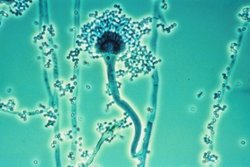| Fungal sinusitis | |
|---|---|
 | |
| Aspergillus is responsible in 90% of cases of fungal sinusitis | |
| Specialty | Pulmonology |
| Symptoms | Facial pain [1] |
| Types | Invasive, Non-invasive [1] |
| Diagnostic method | CT scan, MRI [1] |
| Treatment | Surgical(Management depends on which type) [1] |
Fungal sinusitis or fungal rhinosinusitis is the inflammation of the lining mucosa of the paranasal sinuses due to a fungal infection. [1] [2] It occurs in people with reduced immunity. The maxillary sinus is the most commonly involved. Fungi responsible for fungal sinusitis are Aspergillus fumigatus (90%), Aspergillus flavus , and Aspergillus niger . Fungal sinusitis occurs most commonly in middle-aged populations. Diabetes mellitus is the most common risk factor involved. [3]


